The 1970 Penny: Understanding its Value
The 1970 penny is a Lincoln cent and part of the Lincoln memorial series. Produced by the United States Mint, these coins are made primarily from copper. The value of a 1970 penny can vary significantly, depending on several factors. Condition, rarity, and specific mint mark significantly affect the coin’s value. Understanding these coins and their attributes can give insight into their worth and place in numismatics.
The Mint Marks and Their Impact
The 1970 penny comes with different mint marks, which indicate where the coin was minted. In 1970, pennies were produced in Philadelphia, Denver, and San Francisco. The mint mark can be found below the date on the obverse side of the coin.
- No mint mark: These pennies were minted in Philadelphia. They are generally more common compared to other mint varieties.
- D mint mark: Coins produced in Denver have this mark. They are relatively common but slightly more valued than Philadelphia coins in some cases.
- S mint mark: Pennies with this mint mark come from San Francisco. The S mint mark coins have a few more nuances influencing their value.
Evaluating Condition and Grades
The condition of a 1970 penny plays a crucial role in determining its value. Coin grading is the process of determining the condition, typically on a scale from poor to mint state.
- Circulated coins: These coins have been used in transactions. Signs of wear, such as scratches or faded designs, are usually present. While circulated 1970 pennies have minimal numismatic value, some collectors still find them desirable.
- Uncirculated coins: These pennies show no signs of wear and appear as if they have just left the mint. Uncirculated examples are more valued, often fetching higher prices among collectors.
- Proof coins: Specially made coins with a high level of detail and a mirror-like finish. Primarily meant for collectors, proof coins from 1970 (especially those with an S mint mark) are more sought after and can be considerably more valuable.
Factors Influencing the Value
Several elements can affect the value of a 1970 penny. These include rarity, demand among collectors, and errors during minting.
- Rarity: While most 1970 pennies are common, some specific varieties are rare. Coins with low mintage or unique attributes can command higher prices.
- Collector demand: The popularity of Lincoln pennies among collectors can drive up prices. Coins from key years or those completing a collection series are especially desirable.
- Errors and varieties: Error coins, which feature mistakes from the minting process, often attract a premium. Examples include double die errors or off-center strikes. A well-known variant is the 1970-S small date penny, which is rarer and can be more valuable.
Understanding Mint Errors
Error pennies from 1970 are intriguing to collectors. These coins can fetch significant value depending on the type and visibility of the error. Some common types of mint errors include:
- Double die: A type of error where the coin appears to have doubled elements. This may be visible in the date or other designs on the coin.
- Off-center strike: When the coin is not properly centered in the press, resulting in a partial design.
- Die cracks: Lines on coins created by cracks in the die used to strike them. These can add interest and value to a coin.
Spotlight on the 1970-S Small Date Penny
One of the most talked-about Pennies from 1970 is the 1970-S small date penny. The small date version is rarer compared to the large date equivalent. This difference is subtle, involving the placement and size of the numbers in the date.
The 7 and 0 in the small date are closely aligned, and the 9 is often squared at the top. In large date variants, the numerals are more spaced. Collectors often pay premiums for well-preserved small date examples. The rarity combined with collector interest drives up their price.
How to Assess Your 1970 Penny
If you have a 1970 penny and wonder about its value, a few key steps can help you determine how much it’s worth:
- Look for the mint mark and note its presence or absence.
- Carefully evaluate the coin’s condition, checking for signs of wear or mint luster.
- Identify any possible mint errors or variety differences, such as the small date S mint mark version.
- Consult available resources or have a professional appraisal done by a coin dealer or experienced numismatist.
Paid services by experienced appraisers or using grading companies like PCGS or NGC can provide official grades, adding to the reliability of your coin’s evaluation. Maintained documentation of such grades can help in valuing the coin for potential sales or exchanges.
The Market for 1970 Pennies
The numismatic market for 1970 pennies remains active. Factors such as coin availability, collector interest, and economic conditions impact prices. Auction sites often see significant transactions involving unique or error coins. For most standard 1970 pennies, prices are modest, typically around face value for well-circulated coins. However, uncirculated or proof specimens can be more profitable.
Online sales platforms, dedicated coin shows, and dealer networks are great avenues for finding interested buyers. Sellers with well-documented coins, especially rarities and errors, tend to achieve better sale prices. Engaging with numismatic communities may also provide opportunities to learn and potentially exchange coins of value.
Conclusion
The 1970 penny holds a distinctly modest but intricate place in the world of coin collecting. While many are standard, variations like the small date or coins with notable errors can command higher values. Understanding the specific attributes of these pennies helps collectors make informed decisions. Whether for historic interest or numismatic purposes, the 1970 penny reflects a dynamic blend of American coinage history and collecting interest. Carefully evaluating and understanding these coins unlocks their potential value in a collector’s portfolio.


